I promised myself I would not post this because I have this delusional thought that I am too good of a programmer, yet here we are.
I have altered what I posted earlier last week trying to figure out how to write a VBA function that would write data from an Excel Range to an MS SQL Table. That worked.
Towards the end of the program, I do not know how to construct the final execution of the code; I have tried everything from using the Command.Text in the upper levels, setting it to a Recordset, then executing the recordset, but nothing will make the little VBA troll happy. Here is what I currently have written:
Sub Connection()
Dim Tbl As String
Dim InsertQuery As New ADODB.Command
InsertQuery.CommandType = adCmdText
Dim xlRow As Long, xlCol As Integer
Dim DBconnection As New ADODB.Connection
Dim ConnString As String
Dim rst As New ADODB.Recordset
Dim a As Integer, sFieldName As String
Dim db As DAO.Database
Dim CurrentDb As Database
Dim ConnectionStr
ConnectionStr = "Provider=sqloledb;Server="";Inital Catalog="";Integrated Security=SSPI;User ID="";Password="""
DBconnection.Open ConnectionStr
xlRow = 1 'only one row being used *as of now*, and that is the top row in the excel sheet
xlCol = 119 'First column of misc. data
While Cells(xlRow, xlCol) <> ""
If LH = True Then
Tbl = "Info.CaseBLH"
InsertQuery.CommandText = "INSERT INTO " & Tbl & " VALUES('"
ElseIf RH = True Then
Tbl = "Info.CaseBRH"
InsertQuery.CommandText = "INSERT INTO " & Tbl & " VALUES('"
Else
MsgBox ("No available sheets")
'Application.Quit
End If
NK21Data.TableDefs(Tbl).Fields.Count
For a = 1 To Fields.Count - 1
'For xlCol = 119 To 230 'columns DO1 to HV1
Fields.Item(a) = Replace(Cells(xlRow, xlCol), "'", "''") & "', '" 'Includes mitigation for apostrophes in the data
If Cells(xlRow, xlCol) = "" Then
rst.Fields.Item(a) = "NULL"
End If
xlCol = xlCol + 1
Next a
a = a + 1
Fields.Item(a) = (Format(Now(), "M/D/YYYY") & "')" & vbCrLf)
Wend
'On Error GoTo ErrorHandler
DBconnection.Execute (InsertQuery.CommandText)
DBconnection.Close
Set DBconnection = Nothing
ErrorHandler:
If Err.Number <> 0 Then
Msg = "Error # " & Str(Err.Number) & " was generated by " _
& Err.Source & Chr(13) & "Error Line: " & Erl & Chr(13) & Err.Description
MsgBox Msg, , "Error", Err.HelpFile, Err.HelpContext
End If
End Sub
The error I get is:
Command text was not set for the command object.
This error occurs at:
DBconnection.Execute (InsertQuery.CommandText)
If I try using the following:
InsertQuery = DBconnection.Execute
I will get the following error:
Argument not optional
I've been at this for about (give or take) three days and I'm now having nightmares about it so if someone can help me figure out what to do for this I would greatly appreciate it.
